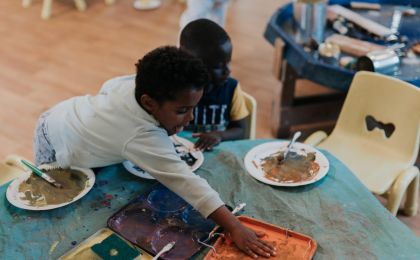
Blog
Mark Making
Mark making is more than just writing and starts from a young age. It is a sensory experience, that develops as they begin to understand that marks can carry meaning and ignites their imagination and creative skills.
Learning to hold a pencil and make marks is what ultimately lead to writing, but children go through a series of complex development of mark making stages to get there.
Initially, it is a physical activity that starts with large movements using the shoulder, wrist, hand and then fingers. The child grasps tools with their whole hand, moving their arm from the shoulder, over time this becomes more refined until children can hold a pencil between their thumb and index finger.
As well as enabling children to learn to write, making marks can benefit a child physically, and help to develop their imagination and creative skills.
Practitioners can have a new insight into a child's thoughts or feelings through the marks they produce
What we do at nursery
From the youngest ages, activities are planned to support the development of children’s fine motor skills and the ability to move freely. We provide children with a range of mark making activities with a large space, music, and a variety of tools for them to choose from to express themselves
Children are encouraged to be independent and free to choose resources they like best and to create marks in the ways which they like best.
What we look out for in young children
- Enjoys the sensory experience of making marks in damp sand, paste or paint.
- Picks up small objects between thumb and fingers.
- Holds pen or crayon using a whole hand (palmar) grasp and makes random marks with different strokes.
- Makes connections between their movement and the marks they make.
- Babies explore media and materials as part of their exploration of the world around them.
- Expresses self through physical action and sound.
- Babies and toddlers need to explore the world and develop a range of ways to communicate before they can express their own ideas through arts and design.
Activity Ideas
- Using a large hand roller to mark make
- Trains or other vehicles dipped in paint can be used to make marks
- Putting paint under cling film and moving it with your fingers
- Painting on foil
- Drawing to the beat of the music using your feet, hands etc.
- Provide different kinds of mark making materials e.g. ribbons, sponges, washing up brushes, tooth brushes, pegs with different things in them, glue spreaders, chunky crayons, chalks, cars, paint rollers, brushes, felt pens, cardboard tubes, paint, feathers, combs, sticks
- Peg a piece of paper to a fence and paint with spray bottles filled with watered down paint.
- Use large chalks for making marks on floor.
- Strengthen the muscles in your child’s arms and hands by providing activities such as playdough, threading, picking up small objects, making shapes in the air with a wand and dancing with a ribbon in their hand.
- Attach pens to toy trucks and roll them around on paper
- Cut small holes in rubber gloves let it drip on paper
- Line a tin that has a lid with paper, roll a ball or marble in paint. Put it in the tin, put the lid on and shake.
- Cover a flat tray with either sand, salt, shaving foam, or sugar. Use fingers and combs to make marks with.
- Roll a ball in paint whilst also bouncing it on the paper
- Explore mark making using materials such as jelly, shaving foam, cornflour, and water
